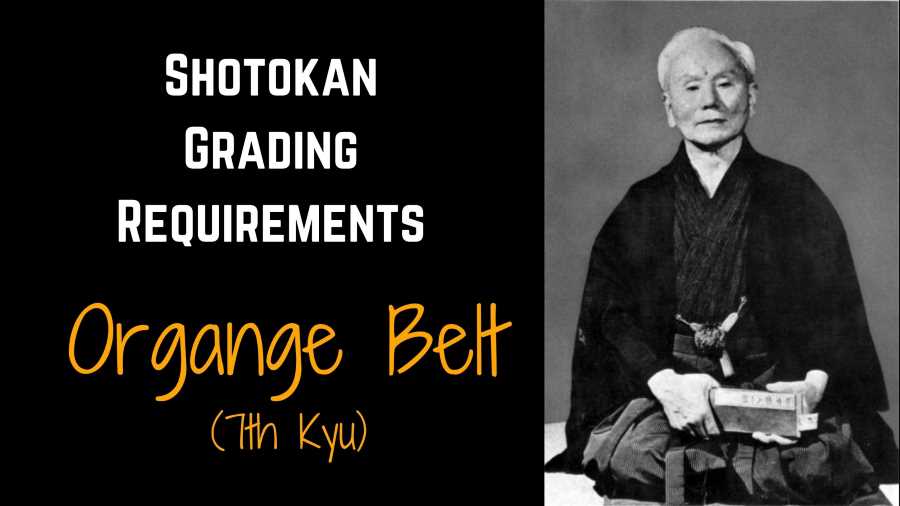In the third post of the series, we will look at what the orange color belt means, the length it takes to get an orange belt, orange belt grading requirements under the Shotokan karate curriculum, how to find out if you are ready for an orange belt grading and how to best prepare for it.
What does the orange belt in karate mean?
In the Shotokan karate curriculum, the orange belt is the third belt you will be awarded and correspond to a 7th kyu rank.
The orange color signifies the sun’s intensity, and a student with an orange belt is thought to have gained more understanding of the basics of karate and shown a strengthened commitment to training.
By now you would have been training in karate for at least 9 months and you are expected to know many of the basic stances and techniques, begin to improve the power of your techniques and have some sparring experience.
How long does it take to get an orange belt in karate?
It takes a minimum of 3 months to get from a yellow belt (8th kyu) to an orange belt (7th kyu).
For some dojos, there may be a required minimum training time such as 36 hours or 20 to 30 training sessions.
In total, so far you would have trained for at a minimum of 9 months in karate but in most cases it’s likely to be longer.
If you have previous martial art experience, the training duration might be shorter, or you might even be considered for a double-grading.
How to find out if you are ready for your orange belt?
As I have previously mentioned in this post, if you have been training consistently, learning at an average rate and meeting the time requirement, you will usually be grading when there is one coming up.
However, it is not automatic and you should never ask your instructor whether you can grade. If your instructor thinks you are ready, he or she will ask you to grade.
Orange belt grading requirements in Shotokan karate
There are four technique areas that you need to demonstrate for your orange belt grading: kihon, kata, kumite and ukemi waza.
1. Kihon
To get an orange belt, you generally need to know the following stances and techniques.
- Stances:
- Zenkutsu Dachi
- Kokutsu Dachi
- Kiba Dachi
- Techniques:
- Oi tsuki
- Gyaku tsuki
- Age uke
- Soto ude uke
- Uchi ude uke
- Shuto uke
- Maegeri
- Yoko geri keage
- Yoko geri kekomi
- Mawashi geri
In the grading, you will be required to perform these techniques in the above three basic stances as listed below. The examiner will count and the general rule is one count, one move.
You are expected to kiai when counter-attack and when perform the last technique of a sequence (usually at number 10).
Try to show a good martial spirit with your kiai as if you are finishing off a real opponent with a single technique.
Oi tsuki (lunge punch) and Gyaku tsuki (reverse punch)
- Start in a ready stance (yoi dachi or shizentai dachi) and then change to a left zenkutsu dachi with a left gedan barai
- Step forward into a right front stance (migi zenkutsu dachi) and perform a lunge punch with the right hand aiming at the solar plexus level (migi chudan oi tsuki), followed by a gyaku tsuki
- Step forward into a left front stance (hidari zenkutsu dachi) and perform a lunge punch with the left hand to the middle (hidari chudan oi tsuki), followed by a gyaku tsuki
- Repeat the above as directed by the examiner.
Gyaku tsuki (reverse punch)
- Start in a ready stance (yoi dachi) and then change to a left zenkutsu dachi with a right gyaku tsuki
- Step forward into a right front stance (migi zenkutsu dachi) and perform a reverse punch with your left hand (hidari gyaku tsuki)
- Step forward into a left front stance (hidary zenkutsu dachi) and perform a reverse punch with your right hand (migi gyaku tsuki)
- Repeat the above as directed by the examiner.
Age uke (rising block) and Gyaku tsuki (reverse punch)
- Start in a ready stance (yoi dachi) and then change to a left zenkutsu dachi with a left gedan barai
- Step backward into a right front stance with the body making a 45 degree with the front (migi hanmi zenkutsu dachi) and perform a rising block with your right hand (migi jodan age uke), followed by a reserve punch (gyaku tsuki)
- Step backward into a left front stance (hidari hanmi zenkutsu dachi) and perform a rising block with your left hand (hidari jodan age uke), followed by a reverse punch (gyaku tsuki)
- Repeat the above technique as directed by the examiner.
Soto ude uke (block from outside inwards) and Gyaku tsuki (reverse punch)
- Start in a ready stance (yoi dachi) and then change to a left zenkutsu dachi with a left gedan barai
- Step backward into a right front stance (migi hanmi zenkutsu dachi) and perform an outside-inward block with your right hand (migi soto ude uke), followed by a gyaku tsuki
- Step backward into a left front stance (hidari hanmi zenkutsu dachi) and perform an outside-inward block with your left hand (hidari soto ude uke), followed by a gyaku tsuki
- Repeat the above technique as directed by the examiner.
Uchi ude uke (block from inside to outside) and Gyaku tsuki (reverse punch)
- Start in a ready stance (yoi dachi) and then change to a left zenkutsu dachi with a left gedan barai
- Step backward into a right front stance (migi hanmi zenkutsu dachi) and perform an inside-outward block with your right hand (migi uchi ude uke), followed by a gyaku tsuki
- Step backward into a left front stance (hidari hanmi zenkutsu dachi) and perform an inside-outward block with your left hand (hidari uchi ude uke), followed by a gyaku tsuki
- Repeat the above technique as directed by the examiner.
Shuto uke (knife-hand block)
- Start in a ready stance (yoi dachi)
- Step backward with your right leg into a back stance (kokutsu dachi) and perform a knife-hand block with your left hand (migi shuto uke), followed by a nuki-te (spear hand counter-attack) in zenkutsu dachi with the right hand
- Step backward with your left leg into a back stance (kokutsu dachi) and perform a knife-hand block with your right hand (hidari shuto uke), followed by a nuki-te (spear hand counter-attack) in zenkutsu dachi with the left hand
- Repeat the above technique as directed by the examiner.
Mae geri (front kick)
- Start in a ready stance and then change to a left zenkutsu dachi, hands in kamae position
- Perform a front kick with the right leg (migi mae geri), landing forward into a right front stance (migi zenkutsu dachi)
- Perform a front kick with the left leg (hidari mae geri), landing forward into a left front stance (hidari zenkutsu dachi)
- Repeat the above as directed by the examiner.
Yoko geri keage (side snap kick)
- Start in a ready stance
- Step to the right hand side into a horse riding stance (kiba dachi) and perform a side snap kick with your right leg (migi yoko geki keage)
- Repeat the above as directed by the examiner (you are likely required to do five kicks to the right and then turn around and do another five kicks to the left).
Yoko geri kekomi (side thrust kick)
- Start in a ready stance
- Step to the right hand side into a horse riding stance (kiba dachi) and perform a side thrust kick with your right leg (migi yoko geki kekomi)
- Repeat the above as directed by the examiner (you are likely required to do five kicks to the right and then turn around and do another five kicks to the left).
Mawashi geri (roundhouse kick)
- Start in a ready stance and then change to a left zenkutsu dachi, hands in kamae position
- Perform a roundhouse kick with the right leg, landing forward into a right zenkutsu dachi (hands in kamae position)
- Perform a roundhouse kick with the left leg, landing forward in a left zenkutsu dachi (hands in kamae position)
- Repeat the above as directed by the examiner.
2. Kata
You will perform Heian Nidan kata for this grading and may be asked to perform Heian Shodan from your previous grading as well.
Below are flawless performances of Heian Nidan kata by Nakayama Masatoshi sensei and Aragaki Misako sensei.
3. Kumite
You are required to perform Sanbon Kumite Number 2.
- Stand in a formal attention stance (Musubi dachi), bow to your partner and then change to a ready stance (Shizentai dachi)
- You will have to do both attacking and defending sides and both left and right sides as follow:
- Step 1: The attacker attacks with Jodan oi tsuki. The defender will defend with Age uke
- Step 2: The attacker attacks with Chudan oi tsuki. The defender will defend with Uchi ude uke
- Step 3: The attacker attacks with Chudan mae-geri. The defender will defend with Gyaku gedan barai (brushing off the outside of the attacker’s leg) and counter attack with Kizami tsuki and Gyaku tsuki (with a loud spirited kiai on the punch).
4. Ukemi waza
Ukemi waza are break-fall techniques.
You are required to perform Ukemi waza level 2 which includes the following techniques:
- Shoulder roll from squatting position
- Side breakfall from squatting position
- Back breakfall from squatting position.
5. Other techniques
Please prepare for situations where you are asked to perform other techniques by the examiner, for example, a combination of previously learned techniques or techniques you’ve performed in previous gradings such as Gohon Kumite, Sanbon Kumite No. 1, or Heian Shodan kata.
How to prepare for your orange belt grading?
By now, you would have trained for at least 9 months and know well the grading procedures.
As with the previous gradings, the preparation for this grading should begin from the day after your last grading.
Always put 100% effort into your training and make the best of your time on the dojo floor. Your personal progress in terms of physical fitness and mental strength is what matters the most. A new color belt is just a nice icing on the cake but should not be what you are there for.
References
The JKA Kyu and Dan Rank Certification System
Shotokan Karate International Australia Grading Syllabus
Understanding the Meaning of Karate Belt Colors
Zanshin Shotokan Karatedo Grading Curriculum
If you find this post helpful, please consider sharing this post and my site with those who might be interested. I would appreciate that a lot.
Please also check out my library of other karate articles which is updated regularly.

